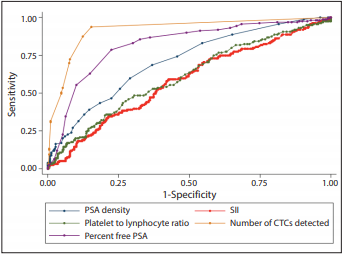Objective: It has been reported that the systemic immune-inflammation index (SII) and platelet-to-lymphocyte ratio (PLR) are higher in men with prostate cancer. We compare their use with the percentage of free prostate-specific antigen (PSA), PSA density, and primary circulating prostate cells (CPCs) to predict clinically significant prostate cancer at first biopsy in men with a PSA of 4–10 ng/mL.
Material and methods: Consecutive men with suspicion of prostate cancer underwent a 12-core transrectal ultrasound-guided prostate biopsy; total serum PSA, the percentage of free PSA, prostate ultrasound to calculate PSA density, and absolute neutrophil, lymphocyte, and platelet counts were used for risk assessment. CPCs were detected using differential gel centrifugation and immunocytochemistry with anti-PSA and anti-P504S. A malignant CPC was defined as a cell-expressing PSA and P504S and defined as positive or negative. Biopsies were classified as indicating cancer or no cancer. Areas under the curve for each parameter were calculated and compared, and diagnostic yields were calculated.
Results: A total of 1223 men participated, and 467 (38%) had a biopsy positive for cancer, whereas 353/467 (76%) had clinically significant prostate cancer. The PLR was significantly higher in men with prostate cancer; there was no significant difference for the SII. The areas under the curves were CPC 0.84, the percentage of free PSA was 0.79, PLR 0.65, PSA density 0.62, and SII 0.46. Neither the PLR nor the SII discriminated between patients with clinically significant prostate cancer, indolent cancer, and benign prostatic disease.
Conclusion: Based on the results of this study, neither the SII nor PLR could differentiate between clinically significant prostate cancer and indolent cancer/benign disease at initial biopsy.
Cite this article as: Murray NP, Fuentealba C, Salazar A, Reyes E. Platelet-to-lymphocyte ratio and systemic immune-inflammation index versus circulating prostate cells to predict significant prostate cancer at first biopsy. Turk J Urol 2020; 46(2): 115-22.

.png)


.png)
